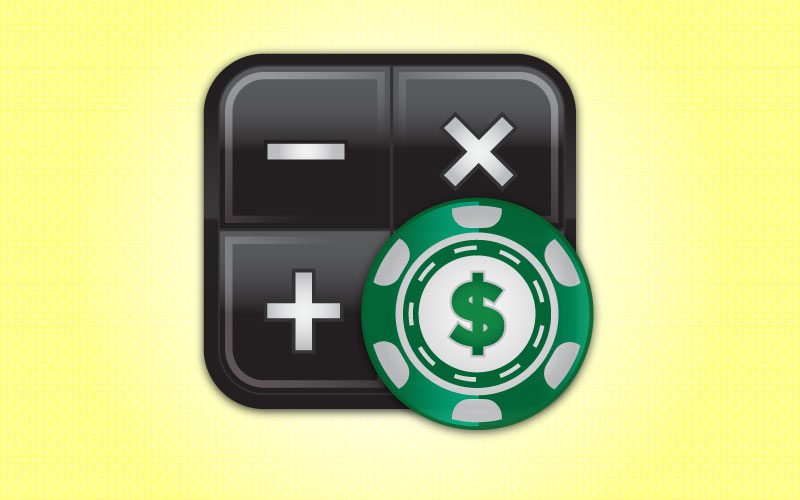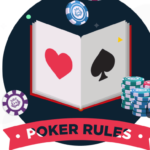I’m sort of at a weird spot in the development of my game. I’m going to type out a bunch of random crap about common drawing spots with straight or flush draws in hopes that it’ll internalize some things I still probably screw up occasionally. Also, I’m hoping questions get asked, comments get made, and this has an end result of making me think deeper about things I take for granted, if that makes any sense.
But anyway, I’ll use $100nl for examples since the dollar amount matches the number of big blinds and it looks all pretty and whatnot (and also since it’s the current stakes I’m playing).
I. Implied Odds on 1 street vs 2 streets
Assume a 9-handed table with $100 effective stacks. You are on the button with A  3
3  , and there are four limpers. You decide to just call behind instead of raising the limpers this time. The SB completes and the BB checks.
, and there are four limpers. You decide to just call behind instead of raising the limpers this time. The SB completes and the BB checks.
The pot is $7 and everyone in the hand has $99 behind. The flop comes K  9
9  8
8  , giving us the nut flush draw. Since there are 47 cards we don’t know and 9 cards that help us, the odds of hitting our draw on the next card is 4.22:1. The SB bets $7 followed by five folds, and it’s $7 to us in a pot of $14, and we call.
, giving us the nut flush draw. Since there are 47 cards we don’t know and 9 cards that help us, the odds of hitting our draw on the next card is 4.22:1. The SB bets $7 followed by five folds, and it’s $7 to us in a pot of $14, and we call.
So if we hit on the turn, how much do we have to extract over the turn and river to make our flop call profitable? Since our pot odds are 2:1 and our chance of hitting are 4.22:1, then the difference is 2.22 times the size of the bet we’re calling, so that’s the amount we have to make up if we hit. This amount is barely over $15.50.
Since after we call, the pot will be $21, we only need to extract about 3/4ths of that over two streets to break even, AND we’re in position. It seems like the call is obvious.
Suppose the turn is a brick, putting the board at something like K  9
9  8
8  J
J  . The pot is $21 and the players have $92 behind each. The SB bets $14, making it $14 to call $35, giving you pot odds of 2.5:1. Now you are presumably 4.11:1 to hit your 9-out draw.
. The pot is $21 and the players have $92 behind each. The SB bets $14, making it $14 to call $35, giving you pot odds of 2.5:1. Now you are presumably 4.11:1 to hit your 9-out draw.
Now if we call, we’re having to make up 4.11-2.5 = 1.61 times $14 when we hit on the river in order to break even. In this scenario, we’ll have to average making $22.50 on the river when we hit to break even on a call.
The river pot will be $49, so if a club comes on the river, it’s likely villain will check since we called a bet on both the flop and the river. To put this into perspective, at this point a $25 bet will break even if it’s called 90% of the time, a $30 bet will break even if it’s called 75% of the time, and a $35 bet will break even if it’s called 64% of the time.
It’s possible that the turn call is profitable against the typical 100nl opponent, but it’s the flop call that’s clearly +EV. Also, if our opponent bets more on the turn, it becomes harder to turn a call into a profitable play, but we can be facing a pot-sized bet on the flop and still figure a call as a profitable play.
II. Picking Up Outs on the Turn
Assume a 9-handed table with $100 effective stacks. A tight UTG raises to $4, there an MP caller ahead of you on the button with T  9
9  . You elect to call, the SB calls, and the BB folds.
. You elect to call, the SB calls, and the BB folds.
On the flop, the pot is $17. The board comes Q  7
7  4
4  , giving you a flush draw. SB checks, UTG bets $14, MP calls $14, and it’s $14 to you in a $45 pot. You’re getting 3.21:1 in position behind two guys who seem to like their hand, so it’s reasonable to believe the call is +EV. SB folds.
, giving you a flush draw. SB checks, UTG bets $14, MP calls $14, and it’s $14 to you in a $45 pot. You’re getting 3.21:1 in position behind two guys who seem to like their hand, so it’s reasonable to believe the call is +EV. SB folds.
On the turn, the pot is $59. Everyone still in the pot has $82 behind. The turn comes the 8  giving you some more outs. Now any spade gives you a flush (9 outs), plus any 6 or J that’s a non-spade gives you a very concealed straight (6 outs). UTG bets $50, and MP folds. Let’s examine the situation:
giving you some more outs. Now any spade gives you a flush (9 outs), plus any 6 or J that’s a non-spade gives you a very concealed straight (6 outs). UTG bets $50, and MP folds. Let’s examine the situation:
The pot is $109 and you’ll be calling $50. You and UTG will both have $32 left behind if you call. Overall, you presumably now have 15 outs and since there are 46 cards you haven’t seen yet, you’ll need 2.07:1 to break even if all of your outs are good. However, you’re getting 2.18:1 on the call, and since the % of time you’ll pick up his remaining $27 on the river is greater than zero, the call is good.
The difference here is that even though you missed on the turn, you picked up outs that turned even a pot-sized bet on the turn into a +EV call for you.
III. Straight Draws are Harder to Detect
Assume a 9-handed table with $100 effective stacks. You are on the button, and there are four limpers. You call. The SB completes and the BB checks.
Consider the differences now in having A  8
8  on a flop of Q
on a flop of Q  9
9 2
2 and in having T
and in having T  8
8  on a flop of A
on a flop of A  9
9  7
7  .
.
While the first scenario lends you to having more outs, in the second scenario, if you hit your hand, it’s going to be much more hidden. When your opponents have a made hand on the flop, say two pair or a set, they’re going to be much more likely to pay you off when you hit your draw in the second scenario than in the first scenario. The reason is simple, straight draws are often harder to pick up on than flush draws. Anyone can see three of a suit on a board, but it’s harder to pick up on when a weird straight draw has hit.
IV. Free Card Plays
The free card play for hold’em is when you raise on the flop in position in an attempt to get your opponent to lead with a check on the turn. Then you check behind, and your raise on the flop essentially bought a free card. Also, you may have fold equity with your raise, an added benefit.
While the extra street you get to see isn’t exactly free, it generally costs less total than you would anticipate if you called both a flop and turn bet. There are numerous examples of this so I won’t give another.
Going along with point III, the free card play is easier to identify if the flop is two-tone, and is much harder to identify if the flop is rainbow. Likewise, you’ll likely have more fold equity with straight draws on a rainbow board. When you’re against a made hand on the flop, the free card play can backfire, but often your opponent will just call and let you check through on the turn, creating a spot where if you hit with a draw that’s hard to see, you’ll often stack your villain.
The free card play followed up with a second barrel on the turn if you miss is also an option, but I won’t get off onto that tangent here.
V. Tainted Outs
In general you should be careful when you have a straight draw on a two-tone flop, or a 8/9-out draw on a paired flop. Often it’s best to just let the draw go if you think your opponent likely has trips. The reason for this is that occasionally you’ll hit your draw, but your opponent will improve as well making a hand better than yours, and you’ll take a big loss in the process. This really kills the value of your draws.
This basically comes down to relative hand strength, a topic Renton covered in one of his post-flop guides.
However, sort of going along with point I, if the turn pairs the board after a relatively safe flop, or puts two to a suit on the board when you have a straight draw, you have to make sure you re-evaluate the new situation correctly instead of just chasing away.
This isn’t meant to be some sort of guide or anything. I’m just looking to open some discussion about some really basic stuff. Feel free to post example hands or whatever you want on the subject.
Submit your review | |










